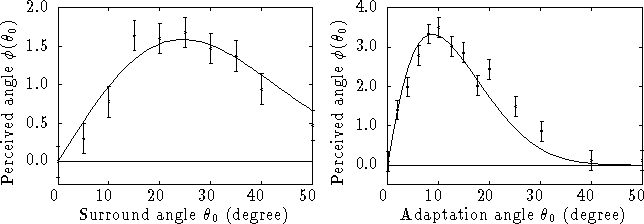 ,
substituting equation (10) into equation (17), it is
not difficult to derive that the network response to stimulus of
angle 0 (vertical) is changed to
,
substituting equation (10) into equation (17), it is
not difficult to derive that the network response to stimulus of
angle 0 (vertical) is changed to



For the orientation adaptation to stimulus of angle  ,
substituting equation (10) into equation (17), it is
not difficult to derive that the network response to stimulus of
angle 0 (vertical) is changed to
,
substituting equation (10) into equation (17), it is
not difficult to derive that the network response to stimulus of
angle 0 (vertical) is changed to
in which  is the feedforward tuning width chosen to be
is the feedforward tuning width chosen to be  and
and  is the parameter of the strength of decorrelation feedback.
is the parameter of the strength of decorrelation feedback.
The theoretical curve of perceived orientation  is
derived by assuming the maximum likelihood of the the neural population,
i.e., the perceived angle
is
derived by assuming the maximum likelihood of the the neural population,
i.e., the perceived angle  is the angle at which
is the angle at which  is
maximized. It is shown in figure 5 (right). The solid line is
the theoretical curve and the experimental data come
from [3] (they did not give the errors, the error bars are
of our estimation
is
maximized. It is shown in figure 5 (right). The solid line is
the theoretical curve and the experimental data come
from [3] (they did not give the errors, the error bars are
of our estimation  ). The parameter obtained through
). The parameter obtained through
 fit is the strength of decorrelation feedback:
fit is the strength of decorrelation feedback:  .
.

Figure 5:
Quantitative comparison of the theoretical predictions with the
experimental data of orientation contrast (left) and orientation
adaptation (right).
It is very interesting that we can derive a relationship which is
independent of the parameter of the strength of decorrelation feedback
 ,
,

in which  is the adaptation angle at which the tilt
aftereffect is most significant and
is the adaptation angle at which the tilt
aftereffect is most significant and  is the perceived angle.
is the perceived angle.


